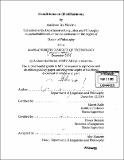| dc.contributor.advisor | Morris Halle. | en_US |
| dc.contributor.author | Nevins, Andrew | en_US |
| dc.contributor.other | Massachusetts Institute of Technology. Dept. of Linguistics and Philosophy. | en_US |
| dc.date.accessioned | 2005-09-27T19:04:14Z | |
| dc.date.available | 2005-09-27T19:04:14Z | |
| dc.date.copyright | 2005 | en_US |
| dc.date.issued | 2005 | en_US |
| dc.identifier.uri | http://hdl.handle.net/1721.1/28920 | |
| dc.description | Thesis (Ph. D.)--Massachusetts Institute of Technology, Dept. of Linguistics and Philosophy, 2005. | en_US |
| dc.description | Includes bibliographical references (p. 291-308). | en_US |
| dc.description.abstract | (cont.) Chapter 4 turns to microvariation within the (dis)harmony system of a single language, examining transparency variation in Hungarian front vowels, and distance-based variation in Hungarian neutral vowel sequences, and in the dissimilative voicing of Embu prefixes. The proposal is that variation results from structural ambiguity within analytic possibilities in the hypothesis space developed in Chapters 1-3. When a configuration encountered early in the learning sequence is compatible with multiple (dis)harmony policies (i.e. parametric settings of harmony grammars), the speaker may choose among these, resulting in variation on those later-learned forms for which the policies diverge in their output. | en_US |
| dc.description.abstract | This thesis explores the formal principles and parameters that model the space of attested, unattested, and microvarying patterns of vowel and consonant harmony. The proposal begins with a target-centric theory, in which harmony is the result of a Search, initiated by a segment "in need". Chapter 1 offers comparison with autosegmental, spreading-based models, arguing that the present model provides an explanatory account of locality effects in "non-constituent" copying in Turkish, Barra Gaelic, and Woleaian. It is proposed that harmony and dissimilation are conducted by the same mechanism--because both display intervener-based locality, and parametric bounds on the domain of search--and that they differ formally only in their structural change. Interveners, excluded from the relativized search domain, may stand between target and source, but search inviolably halts at the closest element within the domain. Chapter 2 proposes that the visibility conditions on interveners can be predicted by properties of contrastiveness within the inventory. Nonetheless, within closely-related languages, microparametrization of value-relativization may lead to dramatic differences in surface harmony patterns. Exemplification comes from three case studies: Standard Yoruba and Ife Yoruba; Sibe and Sanjiazi Manchu; and Kyrghyz, Karaim, and Turkish. Chapter 3 demonstrates that the typology of possible harmony systems has an additional (parametric) determinant: relative sonority. An implicational generalization is proposed: no language has a transparent unpaired vowel of high sonority at the same time it has an opaque unpaired vowel of lower sonority. Exemplification through Hungarian, Wolof, Finnish, and Written Manchu unites seemingly distinct cases of sonority-based | en_US |
| dc.description.statementofresponsibility | by Andrew Ira Nevins. | en_US |
| dc.format.extent | 308 p. | en_US |
| dc.format.extent | 16569031 bytes | |
| dc.format.extent | 16611024 bytes | |
| dc.format.mimetype | application/pdf | |
| dc.format.mimetype | application/pdf | |
| dc.language.iso | en_US | |
| dc.publisher | Massachusetts Institute of Technology | en_US |
| dc.rights | M.I.T. theses are protected by copyright. They may be viewed from this source for any purpose, but reproduction or distribution in any format is prohibited without written permission. See provided URL for inquiries about permission. | en_US |
| dc.rights.uri | http://dspace.mit.edu/handle/1721.1/7582 | |
| dc.subject | Linguistics and Philosophy. | en_US |
| dc.title | Conditions on (dis)harmony | en_US |
| dc.type | Thesis | en_US |
| dc.description.degree | Ph.D. | en_US |
| dc.contributor.department | Massachusetts Institute of Technology. Department of Linguistics and Philosophy | |
| dc.identifier.oclc | 60503647 | en_US |
